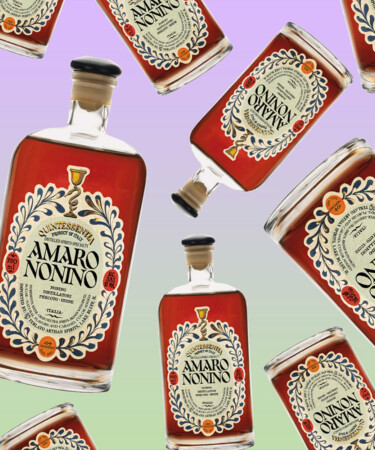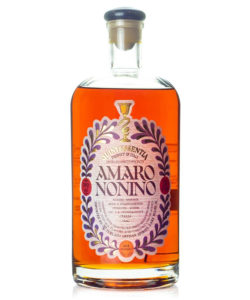The Nonino family has been mastering the art of distilled spirits since 1897 when Orazio Nonino established the brand’s first distillery in Ronchi di Pavia, Italy. The reins of the operation have since been passed down through several generations, with every family member keeping the brand’s innovative spirit alive and maintaining Nonino’s status as a pioneer in the category. While the company started with the production of grappa, a grape pomace-based brandy, Nonino has expanded its product line over time to craft high-quality examples of grape, fruit, and honey distillates, amaro, and liqueurs.
As amaro’s popularity has continued to rise in the U.S., the brand’s flagship amaro — Nonino Amaro Quintessentia — has become a bar staple, often a top choice among bartenders for inclusion in cocktails. While its iconic bottle is now ubiquitous in the drinks scene, there are many facets of the Nonino brand to discover. Here are eight things you should know about Nonino.
Nonino takes being a family business seriously.
Nonino is very proud of its generational heritage and works to honor its family members in every aspect of its business. The Nonino facilities consist of five artisanal distilleries, each equipped with 12 copper batch steam stills, one for each member of the family. Further, the signature L’Aperitivo Nonino bottle showcases three women holding glasses. This represents the three sisters who currently run the distillery — Elisabetta, Cristina, and Antonella — the fifth generation of the Nonino family to make grappa. This is also a tribute to Silvia Ninino, creator of the Apertivo Blanco and the first woman to manage the distillery in a long line of female Nonino distillers.
The brand has always been a pioneer in Italian distillation.
Always looking for ways to improve its craft, Nonino was actually the first distillery to create a single-varietal grappa: the Monovitigno Nonino, made from the pomace of the Picolit grape specifically. This revolutionized the grappa industry, and Nonino continued on to create a line of grappa from the unique varieties of Friuli including Ribolla Gialla and Schioppettino. The Noninos also created a grape distillate, Ùe, which is made from the whole grape as opposed to just the pomace, thus creating a new category of Italian grape spirits in 1984.
Nonino champions Friuli’s native grape varieties.
Speaking of the region’s distinct indigenous varieties, Nonino has actually played a major role in the preservation of local grapes. In 1975, as the Nonino family was searching for native grapes to use in their grappa, they realized that many of the most treasured local grapes were dying out since they were not added to the European Community list of viticultural varieties allowed in Friuli. In an effort to maintain the biodiversity of Friuli’s unique grapes, Nonino set out to have these varieties officially recognized by national and European authorities. The family founded the Nonino Risit d’Aur Prize, which they would award every year to the vine grower who would plant the best new vineyards to these endangered grapes. The award also included a scholarship toward the study of the vines of Ribolla Gialla, Schioppettino, Pignolo and Tazzelenghe. As a direct result, these previously forbidden varieties were authorized in 1977 by Ministerial Decree, and are now a flagship of Friulian wines — and, of course, grappa. The Nonino company has maintained this program (now called Premio Nonino) and it is still awarded to those who support and develop agrarian culture each year.
Nonino prides itself on its natural and traditional production methods.
On Nonino’s website, each product page asserts that the brand uses an artisanal distillation method with no artificial or color additives. This is a testament to the brand’s commitment to both tradition and quality. Drinkers may notice that Nonino’s amaro and aperitivo liquids are a bit lighter in color than many on the market, which is a result of both the ingredients they use and the natural aging process — without the addition of any artificial color. The Noninos have actually been fighting for these distinctions to be required on a mandatory grappa label since the 1970s to ensure that consumers are aware of what they are buying. The law has never passed, so in the meantime, Nonino continues to add these descriptors to its products.
Nonino embraces artisan designs for its specialty products.
When Nonino bottled its first Ùe Grape Distillate Cru Monovitigno Picolit in 1984, it commemorated the occasion by bottling the liquid in stunning artisanal glass bottles. The brand worked with Venini, the master glassmaker on the renowned glass blowing island Murano, to create hand-blown bottles with unique images of grape bunches embedded in the glass. Now, every year, the precious Nonino Collection Ùe Grape Distillate Cru Monovitigno Picolit is stored in specially dated, hand-blown bottles by Venini, Baccarat, and Riedel. When Nonino celebrated its centennial in 1997, the company crafted the Ùe Cru Monovitigno Picolit distillate, aged in Nevers barriques and bottled in 400 specialty numbered bottles made of hand-blown Riedel glass and designed by Luca Cendali.
In 2002, an exhibition in Yokohama, Japan, showcased many of these special bottles in an exhibition titled “Italy in Japan 2001.” The Grappa Nonino Ùe Cru Monovitigno Picolit and the Nonino Collection were exhibited in the section “Design as a lifestyle – Design of senses.”
The Nonino amaro recipe has changed more than once.
Antonio Nonino, the third generation of Nonino distillers, first introduced amaro to the brand’s product line in 1933. He created Amaro Carina by infusing Nonino’s grappa with a combination of herbs from the surrounding mountains of Friuli. After Antonio passed, his wife Silvia took over the distillery and decided to enrich the amaro recipe. In 1940, she selected highly expressive botanicals to give the amaro a stronger personality and named it Amaro del Friuli. Decades later, in 1992, sisters Cristina, Antonella, and Elisabetta decided to replace the amaro’s base of grappa with their Ùe Grape distillate, resulting in the now iconic Amaro Nonino Quintessentia.
Nonino doesn’t just distill grapes.
While the Nonino family established their legacy in distilling grape pomace, their drive for innovation drew them to distill a range of other substances. In April 2000, the Nonino sisters Cristina, Antonella, and Elisabetta introduced Gioiello, a product distilled from pure honey. Nonino now offers three different expressions of this small-batch product including distillates from acacia honey, chestnut honey, and citrus fruit honey. An additional limited quantity of fruit distillate is made each year based on each year’s harvest, including the Il Pirus spirit (made from Italian Williams pears) as well as the Nonino Ginger Spirit, which is made from the maceration and distillation of ginger.
Nonino Amaro Quintessentia is an essential ingredient in a modern classic cocktail.
While Amaro Nonino could be used in countless cocktails, it is most well known for its key role in the Paper Plane, designed by New York City mixologist Sam Ross in 2007. The name was inspired by M.I.A.’s hit song “Paper Planes,” which Ross was listening to when he dreamed up the idea. Now a modern classic, this cocktail is often credited with bringing attention to the amaro category in the craft cocktail scene.

